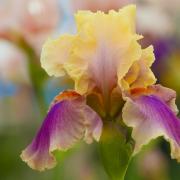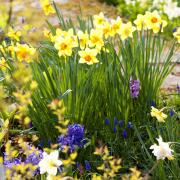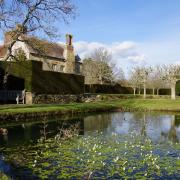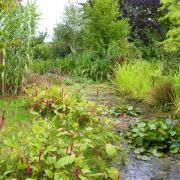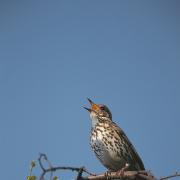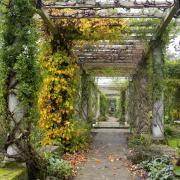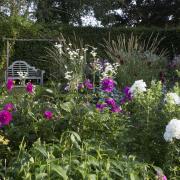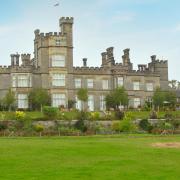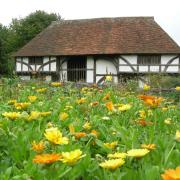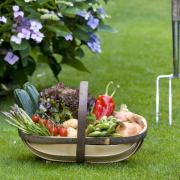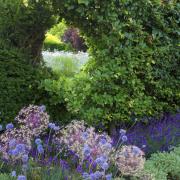Virginia Woolf loved the garden at Monk’s House in Rodmell. For 22 years it was where she wrote most of her novels, in the writing lodge tucked into the corner of the orchard.
It was also an important source of inspiration, and in periods of illness and depression, it soothed her mind. After she took her life in 1941, her husband Leonard remained at Monk’s House until his own death in 1969, and over the course of 50 years, he created a garden that has delighted visitors for decades.
The textiles and homewares designer Caroline Zoob and her husband Jonathan also called it home for ten years, as tenants of the National Trust (which has owned and managed the house since 1980). And now Caroline has penned an elegantly written book about the garden from a distinctly personal perspective, relating how it has evolved since the Woolfs’ day.
The Woolfs bought Monk’s House in 1919 and there is little doubt the garden was one of its principal attractions. Writing to friends, Virginia announced: “Our address will be Monk’s House; the point of it is the garden, I shan’t tell you though, for you must come and sit there on the lawn with me, or stroll in the apple orchard, or pick – there are cherries, plums, pears, figs, together with all the vegetables. This is going to be the pride of our hearts; I warn you.”
Leonard and Virginia took great delight in the garden’s rich harvest. Surplus fruit and vegetables were sold at the Lewes Women’s Institute Market or distributed to friends, and Virginia bottled fruit, pickled beans and became a “very bear where honey is concerned”.
The brick paths weaving between the flower beds, dividing the garden into rooms ranging from the Italian Garden and Walled Garden to the Fish Pond Garden and Virginia’s Bedroom Garden, are one of its most distinctive features. Leonard inherited the brick-paved area in the Fig Tree Garden and continued the theme by creating various terraces, surrounded by flower beds, linked by the ‘golden thread’ of the paths.
“At the height of summer when the borders are lit up it is a magical mystery tour of a garden, each room hidden from the next; scented, shimmering and, to use one of Virginia’s favourite words, vibrating,” says Caroline.
Another distinctive area is the Millstone Terrace, so-named because Leonard came up with the idea of laying four large millstones on each corner of the brick terrace, later surmounted by large terracotta olive oil jars, an idea he may have copied from the garden designer Gertrude Jekyll. As Caroline observes, they are a masterstroke; “their pale ribbed circles like ammonites in rocks”.
In the early days, Leonard favoured commonplace plants such as dahlias, carnations, pinks, wallflowers and asters. But latterly he developed a taste for more unusual species, particularly bulbs. He also liked to raise flowers in his glasshouse and had great success with freesias, carnations, cinerias and gloxinias.
But was Virginia a gardener? It would seem not. She was neither knowledgeable nor technically skilled, and her letters and diaries betray no strong opinions on how the garden should be designed. Instead, she took pleasure in boasting about the garden being “all Leonard’s doing” and enjoyed mucking in when needed.
Her particular pride and joy was the writing lodge, which was moved to the corner of the orchard so she could enjoy the view over the water meadows. A small brick terrace was added and here she gathered with friends.
According to Leonard, Virginia was very disciplined about working, making the journey across the garden “with the daily regularity of a stockbroker”. She wrote the first drafts of her novels in longhand, sitting in a low armchair. Then she would decamp to the desk to type up what she had written. Revisions were often undertaken in the bath or on long afternoon walks.
But dark clouds were gathering about Monk’s House. The Woolfs were living at the property when war was declared in September 1939, and it was quickly followed by a medieval winter when the electricity broke down and they cooked over the fire, sleeping in stockings and mufflers. Even the ink froze in Virginia’s inkwell. It was an ill omen.
Ironically Rodmell, just four miles from the English Channel, became more dangerous than London as invasion seemed inevitable in the weeks after Dunkirk. Leonard and Virginia had a “rather matter of fact talk” about suicide in that event, for which Leonard had made provision with a supply of petrol with which to gas themselves with carbon monoxide in the garage, backed up by a supply of cyanide. This provoked a most painful cry in Virginia’s diary, “No, I don’t want the garage to see the end of me. I’ve a wish for 10 years more, & to write my book which as usual darts into my brain.”
It was not to be. On the morning of 28 March 1941, Leonard wrote to Virginia’s publisher to say that “Virginia was on the verge of a complete nervous breakdown and is seriously ill. The war, food and cold have been telling on her and I have seen it coming on for some time.”
That same day Virginia wrote farewell letters to her sister Vanessa and Leonard, walked to the Ouse, filled her pockets with stones and jumped in. Her last diary entry concerned the garden: “L is doing the rhododendrons.”
After her death, Monk’s House, and more particularly the garden, became the centre of Leonard’s life. He fell in love with a young married art student called Trekkie Parsons and embarked on a romantic if chaste love affair. One thing they shared was the garden at Monk’s House. Trekkie was a keen botanist and enjoyed seeking out unusual specimens. Under her influence, Leonard started ordering plants from specialist nurseries.
In 1951, he opened his garden for the National Gardens Scheme and continued to do so for the rest of his life. On his death in 1969, Trekkie buried his ashes under the surviving elm on the edge of the terrace.
Leonard left the bulk of his estate to Trekkie, who offered to donate all the Woolfs’ papers to the University of Sussex if they would buy Monk’s House at the probate value of £24,000. The university doubted it would be able to provide adequate care for the house and garden, though in the event they took the papers, bought the house and proceeded to let it, with all its contents, to visiting academics.
For nearly a decade, the garden languished, until a number of people began expressing concern, notably Vita’s younger son, Nigel Nicolson, who helped to bring the National Trust and the university together. He felt passionately that the house should be “preserved as the Woolfs knew it”.
Caroline dearly wishes she had been present when the Trust’s restoration team arrived to tackle the garden in 1980. “However neglected it must have been, it was still the closest to what Leonard left behind. But I suspect there was a feeling that the garden had faded away and the best that could be done was to tidy it into an acceptable state for opening and perhaps look at the interpretation as time went by. Perhaps the Trust also felt that people would come to see Virginia’s house and not Leonard’s garden.”
When Caroline and Jonathan arrived in 2000, they increased the variety of shrubs and herbaceous plants, replaced old lavenders and fruit trees and planted numerous roses. Caroline acknowledges that allowing a tenant to tend and maintain a garden open to the public is, for the National Trust, a practical compromise and a gamble. “The Trust recognises it cannot be too prescriptive because the tenant pays for the cost of plants and maintenance. But there were guidelines: we couldn’t change the layout and were advised to garden “in the spirit of Bloomsbury”.
There are people who remember the garden when Leonard was alive; some are adamant that it has changed beyond all recognition and others feel that, given the passage of time, it retains much of the same feel. In 2001 a German student wrote a dissertation on the garden, suggesting it could be restored to reflect only the period 1926-41. “I dread this approach,” says Caroline. “It seems to me the same thing as death for a garden to be pinned to a moment in time.
“The atmosphere is not diminished because the planting in the borders is different and some trees have blown or grown taller. The soul of the garden, which drew the Woolfs to it in 1919 is, I believe, still there.”




